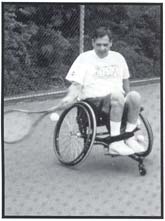

The sport of wheelchair tennis was introduced in 1976 in Southern California via a series of exhibitions and clinics conducted by Brad Parks and Jeff Minnenbraker. Over subsequent years, the sport's popularity and growth led to the formation of two national groups:
Throughout the 1980s, NFWT developed a strong relationship with the national governing body of tennis: The United States Tennis Association (USTA). Due to the efforts of Brad Parks and Bill Fairbanks within the NFWT and Dan Dwyer and Susan Edelstein of the USTA, a Wheelchair Tennis Committee within the USTA was formed and formally approved in March, 1996, by Association President Lester Snyder.
This landmark agreement eventually led to the merger of the WTP A with the USTA's Wheelchair Tennis Committee on January 1, 1998. The committee is comprised of experienced wheelchair tennis directors and players who will ensure a smooth and successful transition from WTPA operations to the USTA. The USTA is believed to be the first national governing body (NGB) to bring under its auspices a national sport organization for individuals with disabilities.
Brad Parks, currently a member of the USTA's Wheelchair Tennis Committee, recently summarized the outcome of the merger:
Susan Edelstein, staff liaison for wheelchair tennis within UST A, maintains that "the merger will give wheelchair tennis more opportunities to grow, thrive, and advance." Founded in 1881, the USTA has 509,000 individual members, 5,997 member organizations, and a $135 million annual budget to train and encourage tennis players of all ages and skill levels. With its 17 geographic sections, UST A will provide wheelchair tennis players with a more direct link to local and regional programs (USTA Annual Report, 1996). In addition to encouraging wheelchair tennis players of all ages and skill levels to participate, Brad Parks has also noted that "the new structure may provide additional opportunities with USTA. It is conceivable that a wheelchair tennis player may be elected President of USTA someday. It is also possible that in the not so distant future, the U.S. Open may hold a men's and women's wheelchair singles championship at Flushing Meadows center court." Furthermore, if the USTA is successful, wheelchair tennis players may become members of the Davis Cup and Summer Olympic teams.
While wheelchair tennis has been successfully integrated into the USTA, seven other major disability sport organizations (DSOs) are only beginning their efforts to achieve integration with their respective 36 NGBs. Historically, the NGBs have had a positive relationship with the DSOs-they have embraced both the athletes with disabilities' struggle for recognition and the Paralympic movement. However, integration of sports for those with disabilities with NGBs has not been a top priority. The NGBs are quite diverse and like the DSOs, the NGBs do not always agree to speak with a common voice (United States Olympic Committee Disabled Sport Organization Retreat, April 4-6, 1997).
To address the issue of integrating the organizations and governing bodies, representatives of the DSOs, NGBs, and the United States Olympic Committee met in April, 1997, at the Disabled Sport Organization Retreat to discuss the matter. Some of the strategies discussed at the retreat to achieve greater acceptance of DSOs by NGBs include: Establish a structure to enable better communication between DSOs and NGBs.
Unfortunately, "sport has remained a somewhat exclusive or elite institution...As for the beginning of the 21st century, individuals with disabilities will remain in the margins of sport" (Disability and Sport, 1995). Despite this pessimistic view, perhaps the success and current structure of the USTA's Wheelchair Tennis Committee can serve as a model for achieving the integration of sports for those with disabilities with the NGBs.